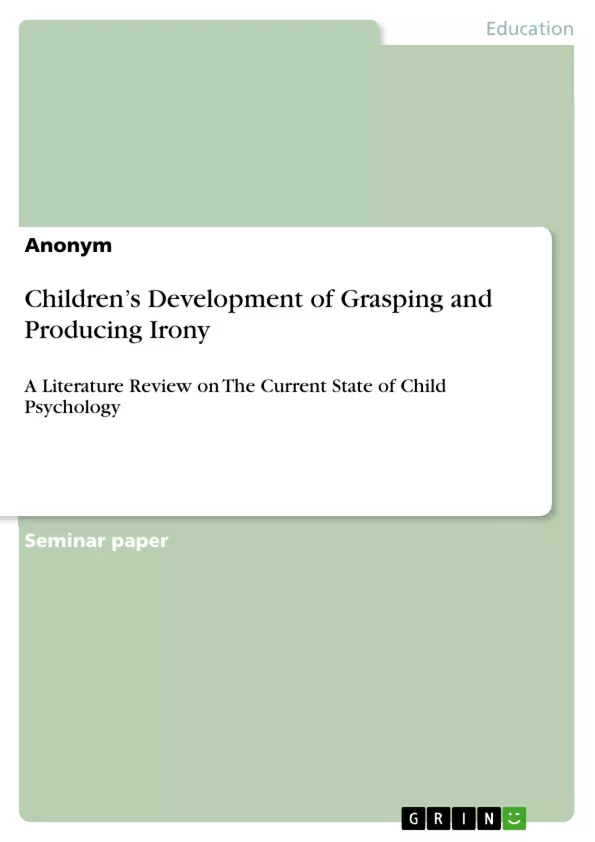This paper deals with children's development of grasping and producing irony. After giving a definition of irony and an extensive overview of its forms, the paper will focus on theories which are currently predominant in the field of child psychology and irony.
"Tim and Jan are [going] to the park for a picnic. […]. As they unpack their food, it begins to rain. Jan comments, ‘What perfect weather for a picnic’." Although Jan’s utterance seems to be positive, in this context he obviously means the opposite of what is said. He uses irony to complain about the bad weather. Conversations like these occur several times a day. Therefore, the competence of grasping irony is important for everyday life and in particular for social discourse. Everyone should be able to understand and practice irony.
However, this can be complex. Irony is not always obvious and can be easily mistaken for lies or understood in a literal meaning. Adults sometimes struggle to detect irony and consequently, misunderstandings in adult conversations can occur. When even adults struggle with irony, one can assume that children do not grasp irony at all. As children are an essential part of our lives and social surroundings, it is interesting to explore the development of children learning to understand, interpret and produce irony.
Table of Contents
- Introduction
- Definition of irony
- Children's understanding of irony
- When children grasp irony
- How children grasp irony
- Children's production of irony
- When children produce irony
- How children produce irony
- Conclusion
- References
Objectives and Key Themes
This literature review aims to examine the current state of child psychology research on children's development of grasping and producing irony. It explores the theories and studies that have shaped our understanding of how and when children learn to comprehend and use irony.
- The development of children's understanding of irony
- Theories of irony comprehension, including the allusional pretense theory, the echoic mention theory, and alternative perspectives
- Factors influencing children's ability to grasp and produce irony
- The role of social context in irony comprehension and production
- The implications of irony understanding for children's social and cognitive development
Chapter Summaries
The first chapter provides an introduction to the topic of irony, highlighting its importance for social communication and exploring the complexity involved in understanding and using irony. It outlines the objectives of the paper and introduces the main theories and research studies that will be examined.
The second chapter defines irony and its various forms, including ironic criticism, ironic compliment, sarcasm, hyperbole, understatement, and rhetorical questions. It offers examples and explanations of each form of ironic language, providing a foundation for understanding the nuances of irony.
The third chapter delves into the research on children's understanding of irony. It explores the argument that children begin to grasp irony around the age of six, but their understanding is limited and evolves gradually over time. The chapter examines different theories on children's irony comprehension, including the allusional pretense theory and the echoic mention theory.
The fourth chapter focuses on children's production of irony, examining research on when children begin to use irony in their own communication. The chapter explores the different forms of irony production and the factors that contribute to children's developing ability to use irony effectively.
Keywords
The key themes and concepts explored in this paper include: irony, irony comprehension, irony production, child development, child psychology, allusional pretense theory, echoic mention theory, sarcasm, social communication, pragmatic understanding, cognitive development.
- Quote paper
- Anonym (Author), 2017, Children’s Development of Grasping and Producing Irony, Munich, GRIN Verlag, https://www.hausarbeiten.de/document/537881


